Great games last night on Sunday Night Football. The Steelers beat the Lions 20-15 and the Astros beat the Dodgers 13-12.
It looked like the Astros would win in regulation, leading 12-9 with little time left. But the Dodgers kicked a field goal in the ninth to force the game to overtime. The Astros won the tiebreaker in the 10th.
Six home runs. 417 pitches. The game took over five hours, starting with the ceremonial first pitch by the 43rd President. As noted by one pundit, “Wow, George W. Bush got us all into a prolonged conflict with no clear winner and murky exit strategy.”
The barrage of World Series homers is being blamed on (credited to?) a juiced baseball or maybe a slicker surface that is hindering the grip on the pitchers’ sliders. Sportswriter Molly Knight tweeted during last night’s game: “All of these baseballs need to be pee tested after the game” and, channeling Rob Manfred, “If we dip the baseballs in gasoline and inject them with andro, I can be the first commissioner to put a baseball on the moon!”. Or as Bill Wakefield emailed to me this morning, maybe it’s the manufacturer:

Today is a travel day for the Series. Looking forward to Game 6 and maybe 7. In the meantime, I am interjecting a non-baseball post. Fats Domino cannot be denied.
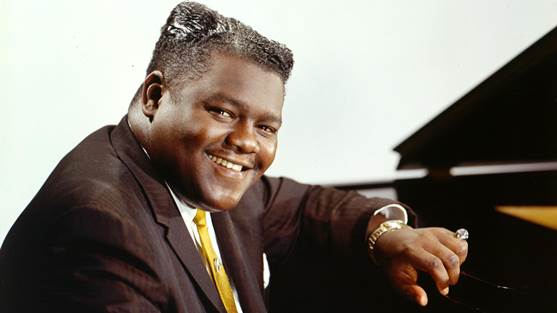
Antoine “Fats” Domino died on October 25. He was 89.
Ain’t That a Shame. My tears fell like rain.
Some 60 years ago (November 3, 1957), I saw Fats perform at Municipal Auditorium in Kansas City.
Five days before he died, I featured his “Ain’t That a Shame” as my Lonnie’s Jukebox selection in Hot Stove #56.
This has definitely been a long term relationship. I never tire of his music, and I love the videos of him playing the piano and flashing his infectious smile. He could do ballads, slow tempo tunes and pounding big beat dance numbers. It was boogie-woogie, R&B and rock ‘n’ roll. Fats scoffed at the idea that rock ‘n’ roll was something new, saying in 1957, “Well, what they call rock ‘n’ roll now is rhythm and blues. I’ve been playing it for 15 years in New Orleans.” The big difference was of course that white teenagers discovered they liked the music and bought his records. So glad we did.
The Original Lonnie’s Jukebox: Just seven months ago, Hot Stove #36 covered the death of Chuck Berry. As I pointed out then, the early rockers provided the soundtrack for my teenage generation. In 2009, for the 50th reunion of Van Horn High School, I wrote a high school memoir based on that soundtrack and titled it “Lonnie’s Jukebox.” Although many artists were included in my 50 record selections, the ones on the Mount Rushmore of my rock memories are Fats Domino, Chuck Berry, Little Richard and Buddy Holly. Buddy was killed in a plane crash in 1959 on the “day the music died.” Chuck died earlier this year at age 90. Fats last week at 89. Little Richard is now 84. I still listen to their music from 60 years ago.
Before “Ain’t That a Shame”: Until “Ain’t That a Shame” hit the charts in July of 1955, I had not heard of Fats Domino. That meant I was at least six years late to the party. It was not all my fault. I was only nine years old when Fats made his first appearance on a Billboard chart with “The Fat Man.” He opened at #4 on the Rhythm & Blues (R&B) chart on February 20, 1950 (see below). His debut would be followed by 12 more top-20 R&B hits before “Ain’t That a Shame” was released.
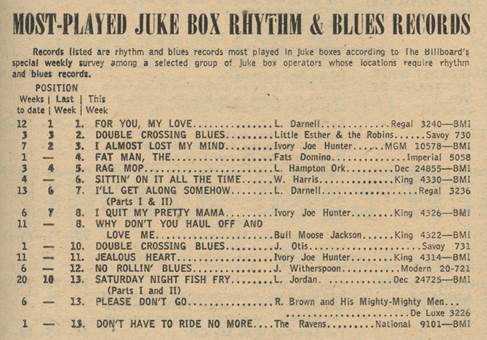
[Kansas City Trivia: If you drop down to #13 in this chart, you will see “Saturday Night Fish Fry” by Louis Jordan. That song is heard every Friday and Saturday night here in KC when Chuck Haddix (a/k/a Haddock) opens his KCUR Fish Fry shows.]
When I started junior high in 1954, I was aware of the new sounds coming out of the radio. “Shake, Rattle and Roll” by Bill Haley had just come out. I was too naïve at the time to recognize that this was not a new song, but instead a white artist cover of Joe Turner’s #1 R&B hit. I didn’t even know there were separate pop and R&B charts that were the music industry version of Jim Crow. It was not pure apartheid – some records were beginning to cross over to be on both charts, including two by Fats: “Goin’ Home” in 1952 (#30) and “Going to the River” in 1953 (#24).
So something was happening. In West Texas, high school musicians Jerry Allison and Buddy Holly listened to the blues on a Shreveport radio station. Per Allison, “The first 45-rpm record I ever bought was ‘Goin’ to the River’ by Fats Domino. That’s one of the first rock ‘n’ roll records I heard.” The vibe was spreading and the teenagers of the 1950’s wanted a lot more of this music. The rock ‘n’ roll revolution was on, and I wanted in.
I ended up buying about 200 45-rpm records during my high school years. This past weekend, I pulled out my ten Fats Domino discs and played them. Lots of hisses and crackles from the old vinyl – loved it. I’ll tell the rest of this story through my five favorite records.
1. “Ain’t That a Shame”: I am pulled into this song by the stop-time cadence that sets off the memorable lyrics. The record entered the pop charts on July 16, 1955. No, I don’t remember the exact date from 62 years ago. I got it from my rock ‘n’ roll bible: Joel Whitburn’s Pop Annual 1955-2010, which compiles all songs in the Billboard Top 100 and organizes them by artist. It tells me that Fats’ record peaked at #10 and was on the pop charts for 13 weeks. It also tells me that the cover by Pat Boone entered the charts on July 29 and went to #1 – now that is a shame.
This is when naïve Lonnie got a music lesson. The Fats version was great. Boone’s was, to be charitable, not (or as the NYT wrote last week, “Pat Boone’s opportunistic cover version remains a disgrace.”). The genre was not really Boone’s territory. The song was co-written by Fats and his long-time producer Dave Bartholomew, a top band leader and trumpeter. The vibe was New Orleans, Fats’ territory. But some radio stations and music buyers were not fully ready for the revolution, so white covers would be around for a while. I had no trouble deciding which versions I would buy.
The Boone cover did have one nice advantage for Fats. Many white record buyers would not have purchased Fats’ version, but Fats and Bartholomew got writer royalties from every Boone sale. It added up. A few years later, Boone attended a concert where Fats was performing. Fats invited Boone out of the audience and gave credit to Boone’s record sales for helping Fats buy the big diamond ring that he flashed to the crowd. They then joined in a duet of the song.
Fats’ record also had some international notice. John Lennon: “Ain’t That a Shame was the first rock ‘n’ roll song I ever learned. My mother taught it to me on the banjo before I learned the guitar.” Last week, Paul McCartney posted this: “Rest in peace Fats Domino…who thrilled us in our early days in Liverpool. His hit records…introduced us to the sounds of New Orleans rock ‘n’ roll…His voice, piano playing and musical style was a huge influence on us.”

Fats and The Beatles – 1964
2. “Poor Me”: In November of 1955, Fats issued his first album, Rock and Rollin’ with Fats Domino. It included some of his R&B hits and some new songs that would soon be on the pop charts. The album had 12 cuts, and the record label also put out smaller 45-rpm “EP” (extended play) albums with four cuts each from the full “LP” (long play) album. All used the same cover art with a woodcut portrait of Fats. I bought one of these back then, and one side has “Ain’t That a Shame” and “Poor Me” and the other has “Bo Weevil” and “Don’t Blame It On Me.”
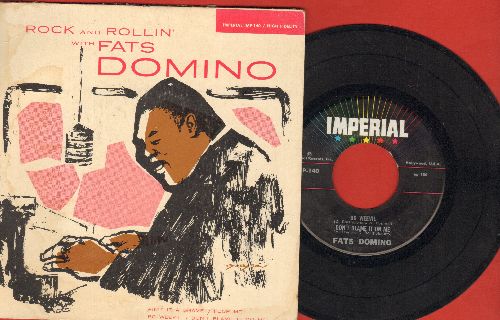
I was surprised that “Poor Me” never made the Billboard national Top-100 pop chart. It was very popular on KC radios stations and at Van Horn Teen Town. In my research for this post, I may have found an answer. Joel Whitburn’s encyclopedic book also references “Territorial” hits that were top-10 lists that Billboard posted for several years for 23 major cities. Although “Poor Me” never made the Top-100 national list, it was a territorial hit in one place: Kansas City. It entered the local chart on December 17, 1955, stayed for four weeks and peaked at #6.
Buy why did it chart only in Kansas City? There was an earlier hint of Fats’ popularity in the territorial numbers for “Ain’t That a Shame” – KC was the only city where the Fats version was #1. Another indicator comes from the FANDOM website which lists gigs played by touring artists. For Fats, the list starts in 1956 and shows that he performed that year at the Orchid Room at 12th and Vine for week long gigs in January (just after “Poor Me” was released) and April. He was also in Kansas City in 1950 (as discussed below) and my guess is that there were dates in between.
[12th and Vine Trivia: Wilbert Harrison’s 1959 hit “Kansas City” made the intersection famous. But it was well known nationally before that. In the 1930’s, jazz and blues clubs were in the area and stretched over to the redeveloped 18th and Vine area that we know today. The likes of Count Basie, Charlie Parker and singing bartender Joe Turner performed in the clubs and gave Kansas City a national reputation. This continued into the 50’s and artists like Fats, Ruth Brown and Ray Charles played at the Orchid Room at 12th and Vine. The area was so well known that 19-year old songwriters Jerry Leiber and Mike Stoller wrote “Kansas City” in 1952 even though they had never been here. They had their song recorded by Little Willie Littlefield (as “K.C. Lovin’”), but the monster hit by Wilbert Harrison came in 1959. Today, 12th and Vine is a park.]
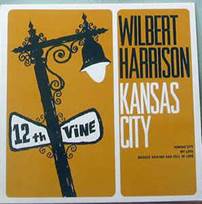
[12th and Vine Trivia, Part 2: I graduated from high school about the time Wilbert Harrison’s “Kansas City” hit #1. My buddies and I settled into an American Graffiti summer – drag strip, drive-ins, not catching girls, listening to rock ‘n’ roll…but mostly just cruising. And Harrison’s song naturally got us to 12th and Vine. Bill Lochman, Jim Graham, Lonnie Offineer and I (yes, 2 Lonnies) cruised through the entertainment district that stretched from 12th and Vine to 18th and Paseo. It all looked like so much fun, so we parked and went into one of the clubs. We were only 17/18 and rarely drank then. In the relaxed regulatory environment of the times, we were shown to a table next to the stage of the Blue Room (not today’s version near the Negro Leagues Baseball Museum, but the original in the former Street Hotel). There we were, tee shirts and jeans, in a house otherwise full of people dressed to the nines. Then the entertainment hit the stage. It was Dizzy Gillespie. We finished our one beer and left with a cool memory that we did not share with our parents.]
Little Richard: I pause here to mention another singer covered by Pat Boone. On January 14, 1956, Little Richard announced himself to the world by screaming “AWOPBOPALOOBOP ALOPBAMBOOM” as he charged into his “Tutti Frutti.” Three months later, he delighted us with “Long Tall Sally.” Pat Boone quickly brought out his covers of both songs. Little Richard peaked at #17 with “Tutti Frutti,” Boone at #12. “Long Tall Sally” was a top-10 hit for both of them. Just listen to the first few bars of each to make your pick: Boone and Little Richard.
It’s not that covers are a bad thing. “Kansas City” has been covered over 300 times. Buddy Holly, Elvis Presley and the Beatles covered Fats, Little Richard and Chuck Berry. The first hit for Elvis on RCA was “Hound Dog,” a cover of a 1953 #1 R&B hit written by Leiber and Stoller and performed Big Mama Thornton. The difference is that the covers by Boone (and many others) were put out to satisfy that part of the public that would not buy records by black artists. This was often endorsed by major record labels, and that is why you find most of the original black rockers on independent labels. Many radio stations were also guilty. In Kansas City, WHB’s white-only playlist pushed teenagers like me to KUDL to get Little Richard, Fats, etc. WHB later changed its policy.
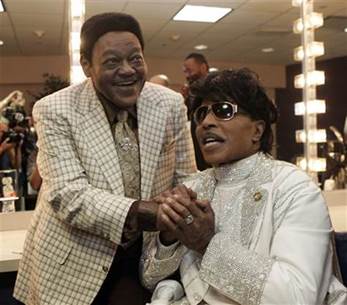
Fats and Little Richard
3. “Blueberry Hill”: In a big twist, Fats covered a song first released by several white artists. “Blueberry Hill” had many versions back in 1940, including hits by Gene Autry and Glenn Miller. But it was a 1949 version by Louis Armstrong that caught the attention of Fats who then added his unique style to record what became his top hit. It entered the Billboard pop chart on October 6, 1956, stayed for 27 weeks and peaked at #2.
An excellent biography of Fats came out about 10 years ago: Blue Monday – Fats Domino and the Lost Dawn of Rock ‘n’ Roll, by Rick Coleman. It proved to be a wonderful reminder of how much I appreciate Fats Domino. Coleman’s description of the reaction to “Blueberry Hill” is consistent with how I remember our adolescent world reacting. On the crude side, some boys (I won’t say who) would replace the song title with their fantasy girl (“found my thrill on….and lingered until my dreams came true”). Coleman expands on the innuendo:
“[Domino’s] warm Creole drawl evoked a misty tryst of romantic mystery as the record became a primary soundtrack for slow dancing and making out; the sexual implications of the lyrics riveted teens hopped up on suppressed hormones. Domino’s delivery impressed…Leonard Cohen, who names it as his all-time favorite song. ‘You want to hear a guy’s story,’ says Cohen…’When you hear Fats Domino singing ‘I found my thrill on Blueberry Hill,’ whatever that’s about, I mean, it’s deep.’”
4. “Blue Monday”: There is an account in Rick Coleman’s book of how this song originated during a stopover in Kansas City. Fats was touring with David Bartholomew and his band in November of 1950. The group traveled from city to city in two station wagons that were often plagued by flat tires. They had a gig at a nightclub in Independence, Missouri, but got stiffed on their pay. Even worse, a blizzard hit, and the Louisiana boys wanted to get back home to warmer weather. Fats got his parents to wire him some money so he could return by bus. The others waited out the weekend and then decided to stay one more day to take in Kansas City’s famed “Blue Monday” shows in the jazz and blues clubs on Vine Street.
“When the band finally headed home, Bartholomew, inspired by the Kansas City musicians, scribbled down a song he called ‘Blue Monday.’ ‘That came from me just knowing about the working man,’ he says. ‘But these guys were having a good time on Blue Monday. Lew Chudd said that’s the best song I ever wrote, because it was actually life itself.’ “
Lew Chudd was the owner of Imperial Records, the label for Domino and Bartholomew. The song would first be recorded in 1954 by Smiley Lewis, another singer on the Imperial label. But it was the Fats treatment two years later that made it a classic. Fats’ version hit the Billboard pop chart on January 5, 1957, stayed for 18 weeks and peaked at #5.
Fats sang “Blue Monday” in the 1956 movie The Girl Can’t Help It, where he was joined by Little Richard, The Platters and other rock acts. The title came from a Little Richard song, and the girl in the movie was played by Jayne Mansfield. Click here to see Fats in the movie (1:40).
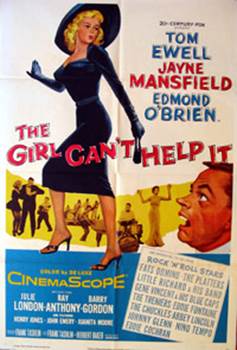
5. “I’m Walkin’”: The four Fats songs discussed above were slow tempo, but Fats also had many “Big Beat” songs (including one by that name). The best for me is “I’m Walkin’” with its catchy handclapping start. Its magic holds up to this day. When it hit the charts on March 9, 1957, Fats had four hits in the Billboard Top-100: “Blue Monday” at #10, “I’m Walkin’” at #35, “Blueberry Hill” at #43, and “What’s the Reason (I’m Not Pleasing You)” at #83.
The Fats version of “I’m Walkin’” peaked at #4, coincidentally at the same chart number reached by Ricky Nelson’s monotone cover version. Nelson’s version belongs in the junkyard with Pat Boone’s covers.
Biggest Show of Stars: Irvin Feld and his brother owned a chain of record stores in the Washington DC area and booked and promoted musical and comedy acts. They were also top promoters of the Ringling Brothers Circus. Their “Big Shows” started with jazz caravans, and in 1956, they started booking rock ‘n’ roll tours. I attended Feld’s fall tour of the “Biggest Show of Stars” that hit Kansas City on November 3, 1957. The tour had 80 shows in 28 states and 5 provinces in Canada.
I got my tickets from classmate Tom Foley who had won them through a radio promotion. His parents would not let him go because it was a Sunday night – school the next day. My parents no doubt had reservations, but they knew my passions. Two years earlier they had let me cut school to see the A’s first major league game. Now I was buying rock ‘n’ roll records that they were hearing from my bedroom. They knew I had to go.
I had turned 16 and had my driver’s license, but not my own car. This issue was solved by giving the other ticket to my next door neighbor Jimmy Mitchener. He was a year older and had wheels. The concert was so long ago that I cannot vouch for what songs I heard. We had no idea we were witnessing songs that would become classics and being sung by artists who would someday be inducted into a Rock and Roll Hall of Fame. We just knew we liked it in the moment.
Acts came and left during the tour, and all white acts were dropped for five stops in the south where integrated performances were not allowed. I could not find a poster for the KC concert, but I did for the one two days later in Topeka.
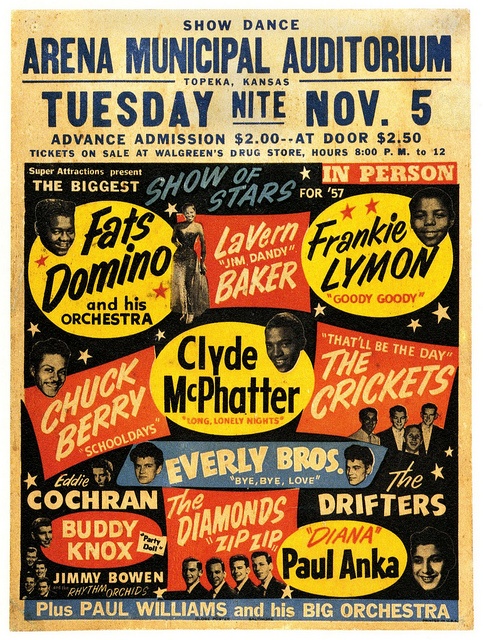
The KC Times headline for our show read ROCK ‘N’ ROLL DELIGHT. The sub-headline: CROWD SHOUTS, STOMPS THROUGH PERFORMANCE. And then the lede: “Man, Daddyo, they really broke it up in the arena of the Municipal Auditorium last night.” According to the article, the show did not start until 10:30 PM. Tom Foley’s parents would not have been happy. I doubt mine were pleased.
The article says the concert started when Chuck Berry “bounded onto the stage with ‘School Days’ and the crowd suddenly looked as if it must have taken its Asian flu shots with juke box needles.” Eddie Cochran “wiggled and shouted.” Squealing greeted Fats Domino in his shiny maroon tux and he broke out with “My Blue Heaven.” Wilt Chamberlin was there. The Everly Brothers were not – Don had the flu.
The poster gives some clues on the rest of the setlist: “Goody Goody” (and probably “Why Do Fools Fall in Love”) by Frankie Lymon, “That’ll Be the Day” by Buddy Holly and the Crickets, “Jim Dandy” by LaVern Baker, “Party Doll” by Buddy Knox and “Diana” by Paul Anka. I presume the Diamonds sang “Little Darlin’.”
I remember that when the crowd filed out, a lot of empty liquor bottles were exposed on the arena floor. The Star said “some square” threw a bottle at the Drifters and that police were boxing up jugs from the floor. I did not discuss this with my parents.
Katrina/Treme: Fats was proudly a product of New Orleans. When Katrina hit in 2005, he declined to leave his home. After flood waters inundated the Ninth Ward, Fats was rescued, but he lost his gold records and the National Medal of Arts award given to him by President Clinton. His recording companies replaced the gold records and President George W. Bush personally delivered a new medal to Fats.
Rita and I watched the four seasons of the HBO series Treme. The timeline started three months after Katrina and covered the woes of rebuilding the city and the joys of the music and the culture. In season three, there was an episode where a local deejay and young musician go to Fats’ office to see if the legend will participate in a festival. As the musician plays at the piano, Fats joins in on “Blueberry Hill.” I first thought he was lip-synching because it sounded so good and he would have been about 84 at the time. But he changed out some words, so it was improvised and live. See it here (1:35) and don’t miss the gold records on the wall and the tail-fin couch.
So Many Hit Records: Starting in 1950, Fats became a regular on the R&B charts. After crossing over with two modest pop hits, he hit big with “Ain’t That a Shame.” This started a string of 64 records on the Billboard Top-100 during the 10-year period from 1955 to 1964. His last in this time period was “Heartbreak Hill” that peaked at #99 – the flip side was a cover of “Kansas City.” Sadly, he never had a #1, but he did have 11 Top-10 hits. He had 23 gold records and sold 65 million singles.

Fat continued to record, but he only charted one more time (and just barely, at #100). That was in 1968, ironically a cover of a white band’s song, “Lady Madonna” by the Beatles. It may be the best cover of any Beatles song, and that makes sense when Paul McCartney tells the story about his inspiration : “Lady Madonna was me sitting down at the piano trying to write a bluesy boogie-woogie thing…it reminded me of Fats Domino for some reason, so I started singing a Fats Domino impression. It took my other voice to a very odd place.” The song is about a hard working woman, making it a nice bookend to the men of “Blue Monday.” “Lady Madonna” was a single from his album Fats is Back, and another single from that album was a Beatles cover about my wife: “Lovely Rita” (that meter maid).
In 1986, my Mount Rushmore of Fats, Buddy, Chuck and Little Richard were four of the inaugural class of inductees at the Rock and Roll Hall of Fame. The other six were Elvis Presley, James Brown, Ray Charles, Jerry Lee Lewis, Sam Cooke and the Everly Brothers.
Time to Listen to the Music: Last week, Billboard did a good summary of Fats on the charts. The article concluded with easy links to eight of his hits, so sit back and find yourself in Blue Heaven with the sounds of Fats.
One thought on “Hot Stove #58 – Fats Domino – RIP – Ain’t That a Shame”
Comments are closed.